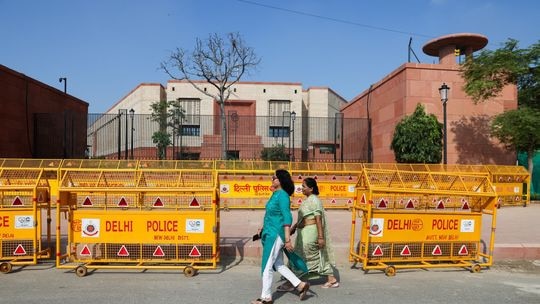India to reserve a third of lower parliament for women
New law, once implemented, paves the way for higher numbers of female representatives across the country.

India’s parliament has approved landmark legislation that will reserve one-third of seats for women in the lower house of parliament and state assemblies, a step that could help boost the share of Indian women in other workplaces and public spaces.
“A defining moment in our nation’s democratic journey!” Prime Minister Narendra Modi said on X, the social-media platform formerly known as Twitter, after the bill’s passage, adding it will “usher in an era of stronger representation and empowerment for the women in India.” The bill cleared the lower house on Wednesday and the upper house on Thursday. Once signed by the president, it will ensure a quota for women lawmakers for a period of 15 years. Within the seats reserved for women, there will be a quota for women from tribal communities and those at the bottom of the Hindu caste ladder.
The law won’t apply to the upper house of parliament.
The quota won’t be implemented in time for national elections in 2024. Experts expect it will only come into effect after India’s next census, which will allow the country to update electoral boundaries, and decide which seats to designate for female representatives. That process will take several years.
India has made strides in increasing the political representation of women in village councils and local urban bodies after a similar quota was put in place in the 1990s. And India’s political scene has showcased women in powerful positions from prime minister Indira Gandhi to the country’s current President Droupadi Murmu, elected last year.
But women are severely under-represented in the national parliament and state assemblies where the important political and economic decisions are made.
Indian women hold 15 per cent of India’s parliament seats and about 10 per cent of seats in state legislative assemblies, India’s law minister Arjun Ram Meghwal said in parliament. Once the new legislation comes into effect, the number of women lawmakers in the 543-member lower house would go up to 181 from 82 at the moment, Mr Meghwal said.
Women also make up a disproportionately low share of the overall workforce compared with other major economies in Asia. Having more women in India’s parliament is a crucial step forward that will pave the way for more women in other kinds of employment, said Ashmita Gupta, who focuses on gender equality at the Asian Development Research Institute, in India’s Bihar state.
“More women in the workforce is important for economic growth,” she said.
Despite being the world’s fastest-growing major economy in recent years, India has failed to bring more women into the labour force because of weak job creation and a conservative culture that emphasises a woman’s place is in the home. Only 38 million women were in paid employment in India last year, compared with 368 million men.
Ms Gupta also said having more female lawmakers would make government decision-making and legislation more representative for a huge swath of the country’s population.
India has been trying to set up quotas for female lawmakers for more than two decades, but previous legislative efforts foundered.
A report by the Inter-Parliamentary Union, which compiles global data on national parliaments worldwide, ranks India at 141 out of 187 countries, when it comes to women’s representation in the top legislative body.
Arundhatie Biswas, a senior fellow at the New Delhi-based think tank Observer Research Foundation, said the law’s passage opens a window of opportunity to close that gap.
“The participatory inclusion and leadership of women in the electoral processes of a country is a key indicator of its democratic well-being,” Biswas said.
The Wall Street Journal


